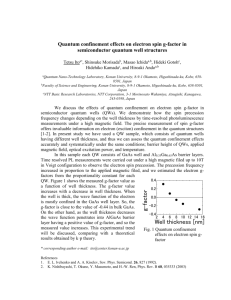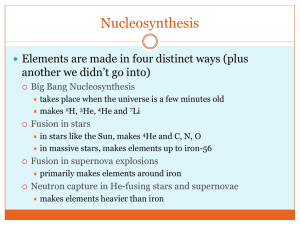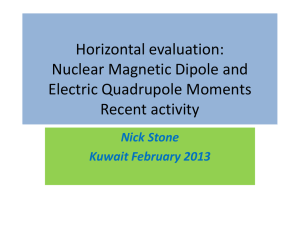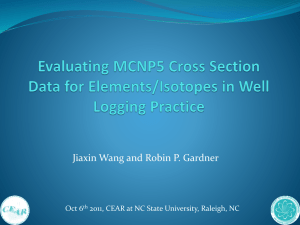g-factors and spin-polarization of 31,32,33,34Al
advertisement
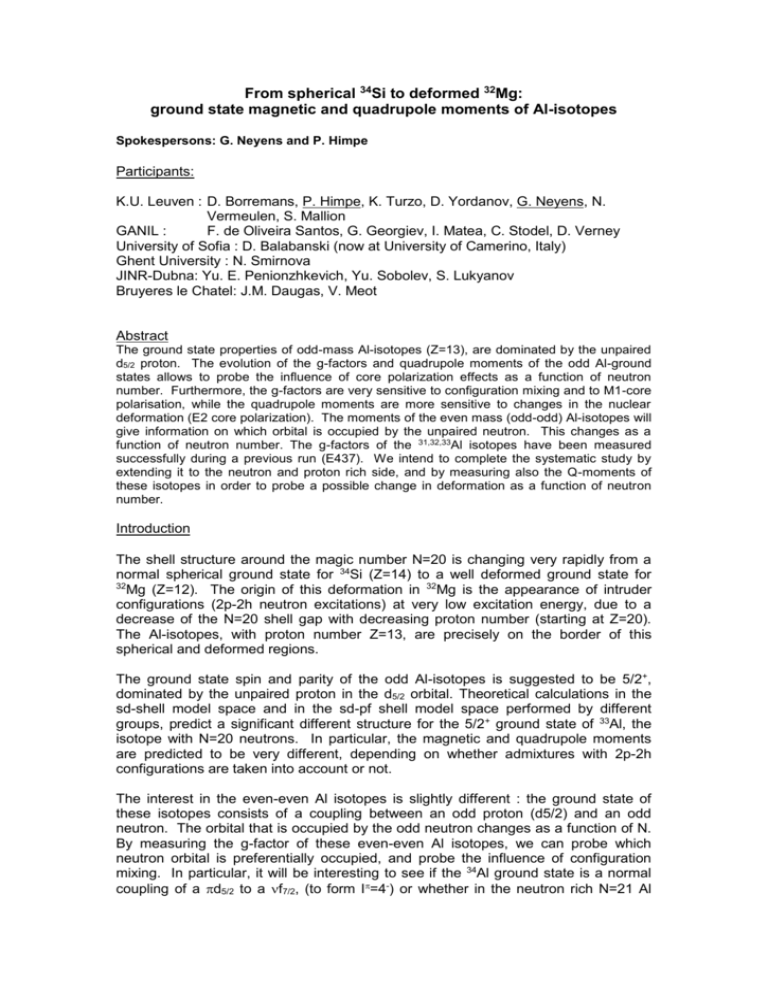
From spherical 34Si to deformed 32Mg: ground state magnetic and quadrupole moments of Al-isotopes Spokespersons: G. Neyens and P. Himpe Participants: K.U. Leuven : D. Borremans, P. Himpe, K. Turzo, D. Yordanov, G. Neyens, N. Vermeulen, S. Mallion GANIL : F. de Oliveira Santos, G. Georgiev, I. Matea, C. Stodel, D. Verney University of Sofia : D. Balabanski (now at University of Camerino, Italy) Ghent University : N. Smirnova JINR-Dubna: Yu. E. Penionzhkevich, Yu. Sobolev, S. Lukyanov Bruyeres le Chatel: J.M. Daugas, V. Meot Abstract The ground state properties of odd-mass Al-isotopes (Z=13), are dominated by the unpaired d5/2 proton. The evolution of the g-factors and quadrupole moments of the odd Al-ground states allows to probe the influence of core polarization effects as a function of neutron number. Furthermore, the g-factors are very sensitive to configuration mixing and to M1-core polarisation, while the quadrupole moments are more sensitive to changes in the nuclear deformation (E2 core polarization). The moments of the even mass (odd-odd) Al-isotopes will give information on which orbital is occupied by the unpaired neutron. This changes as a function of neutron number. The g-factors of the 31,32,33Al isotopes have been measured successfully during a previous run (E437). We intend to complete the systematic study by extending it to the neutron and proton rich side, and by measuring also the Q-moments of these isotopes in order to probe a possible change in deformation as a function of neutron number. Introduction The shell structure around the magic number N=20 is changing very rapidly from a normal spherical ground state for 34Si (Z=14) to a well deformed ground state for 32 Mg (Z=12). The origin of this deformation in 32Mg is the appearance of intruder configurations (2p-2h neutron excitations) at very low excitation energy, due to a decrease of the N=20 shell gap with decreasing proton number (starting at Z=20). The Al-isotopes, with proton number Z=13, are precisely on the border of this spherical and deformed regions. The ground state spin and parity of the odd Al-isotopes is suggested to be 5/2+, dominated by the unpaired proton in the d5/2 orbital. Theoretical calculations in the sd-shell model space and in the sd-pf shell model space performed by different groups, predict a significant different structure for the 5/2+ ground state of 33Al, the isotope with N=20 neutrons. In particular, the magnetic and quadrupole moments are predicted to be very different, depending on whether admixtures with 2p-2h configurations are taken into account or not. The interest in the even-even Al isotopes is slightly different : the ground state of these isotopes consists of a coupling between an odd proton (d5/2) and an odd neutron. The orbital that is occupied by the odd neutron changes as a function of N. By measuring the g-factor of these even-even Al isotopes, we can probe which neutron orbital is preferentially occupied, and probe the influence of configuration mixing. In particular, it will be interesting to see if the 34Al ground state is a normal coupling of a d5/2 to a f7/2, (to form I=4-) or whether in the neutron rich N=21 Al isotopes, the ground state is governed by the d3/2 (to form a positive parity state). It was suggested recently that the ground state of 33Mg, the isotone of 34Al, is indeed governed by this d3/2 neutron state. A g-factor measurement (subject of another proposal) will have to confirm that. Several theoretical calculations have been performed in order to explain the properties of nuclei around the Island of Inversion. While most of these models are now able to describe rather accurately the experimentally determined properties of the even-even nuclei, their predictions about the properties of the odd nuclei are not always in agreement with each other [Cau02, Uts01]. The reason is because in odd nuclei the unpaired proton or neutron plays a crucial role in the structure at low excitation energy. If the single particle levels in the shell model have slightly different energy gaps, this has an immediate consequence on the low-energy structure of the odd nuclei. In particular the properties of nuclei at the border of the ‘Island of inversion’ are crucial ingredients to fix the monopole part of the shell model Hamiltonian. Results from previous runs related to this proposal. In a recent experiment, july 2003, we have been able to measure the g-factor of the 33 Al ground state. The preliminary result from an on-line analysis is shown in the left of figure 1. The quoted error bars will still be reduced by factor 2 to 5, because a carefully calibration of the magnetic field needs to be preformed off-line. Figure 1: g-factor measurements on 31,32,33Al ground states, results from E437, july 2003 The interpretation of this data should allow to determine if the 33Al ground state is rather a ‘normal’ state, or whether some admixture with 2p-2h excitations of the neutron core are needed to reproduce the experimental result. The analysis of these data is still in progress, but from the on-line result is can already be deduced that the g-factor is smaller than predicted for a pure sd-shell state [Him04]. Some admixture with neutron 2p-2h excitations into the wave function will be needed to reproduce the experimental value, as demonstrated in figure 2. It that same experiment, we have also performed precision measurements on the 31 Al and 32Al ground state g-factors. The 31Al g-factor had been measured a few years ago by our collaboration [Bor02]. From the good agreement of the measured gfactor with a calculated value from the sd-shell model (using USD interaction), we could deduce that he ground state spin/parity of 31Al is 5/2+. A g-factor is however indirectly sensitive to the nuclear spin, by comparing the deduced magnetic moment with theory prediction. Only for nuclei with a structure that is rather well understood, this ‘indirect’ determination of the spin via a g-factor measurement is possible (this is demonstrated e.g. in [Ney03a]. A direct measurement of the spin is possible using the Level Mixing Resonance (LMR) technique [Ney97]. This technique also allows to measure the quadrupole moment, provided the magnetic moment is known. The measured quadrupole moment could further confirm if the 5/2+ ground state is indeed, as predicted, very little influenced by admixtures of 2p-2h states into the wave function. Figure 2: Comparison of experimental magnetic moments with shell model calculations for 5/2+ ground states in odd mass Al-isotopes. The LMR-method has been used a few years ago, to measure the ground state moments of 31Mg (E314) [Teu01, Ney01, Ney03]. The result from that experiment was rather ‘intriguing’, because the number of resonances, as well as the position between the observed LMR resonances, clearly showed that the spin of the investigated state was 7/2. Such a state is most likely the 7/2- 1p-1h neutron excited state. Whether this is the ground state, or an isomeric state, could not be concluded from this work, neither whether it was a - or decaying isomer [Teu01]. Earlier beta-decay work [Klo93] suggested a (3/2)+ for the 31Mg ground state. The presence of a long-lived 7/2- state, next to a 3/2+ state in 31Mg, would be a clear signature for shape coexistence in this nucleus. Publication of this result, including a discussion, has been delayed, until the presence of two beta-decaying states could be confirmed more firmly. Last week, by measuring the hyperfine structure of an optically polarized 31Mg beam at ISOLDE-CERN, we could show indeed the presence of two -decaying states in 31Mg with opposite sign for the g-factors, as expected for a 3/2+ and 7/2- state. The data need still to be analysed more carefully of course. Also good-quality lifetime curves have been obtained, as well as coincidence data from the 31Mg beta-decay (these are data from the april 2003 run, E314b, which are still under analysis). Finally, in the july 2003 run, we have been able for the first time, to demonstrate the presence of spin-polarization in a projectile pick-up reaction: for 34Al (N=21) produced from a 36S (N=20) beam, we have measured the largest amount of spin-polarization at the maximum of the yield distribution (figure 3, right). Furthermore, we have found a method to measured the spin-polarization BEFORE the moment measurement starts, which was not possible till now. Until now, the spin orientation was deduced from the amplitude of the measured resonances, while the position of the resonances gave us information on the nuclear moments. The new method to deduce the asymmetry, is by measuring the decay-asymmetry with and without applied magnetic field, which can be done in about 15-30 min. of beamtime. We have compared the amount of experimental asymmetry measured by both methods, for the 3 investigated Al isotopes, and very similar values are obtained, as shown in figure 4, middle. The large difference in -asymmetry measured for the 4 isotopes, reflects partly the difference in the asymmetry parameter of the -decay. The high asymmetry parameter for 32Al is because its -decay is governed by a Gamov-Teller transition (32Al, 1+ 32Si, 0+), while in the other Al-isotopes the decay is spread over several transitions. With a new crystal holder it is now also possible to implant the selected isotope in different crystals, without breaking the vacuum. That, in combination with a fast asymmetry measurement, allowed to find the crystal in which the polarization was maintained the best (figure 4, right). Figure 4: (Right) Measured asymmetry in the decay of a polarized 34Al beam, selected in different windows of the longitudinal momentum distribution. The corresponding detected yields are shown below. (Middle) Measured asymmetry for the different Al-isotopes, as deduced from the new ‘fast’ method and from the NMR resonances. (Left) Measured decay asymmetry for 29Mg and 31Al in different implantation crystals. Beamtime Request (1) g-factor of 34Al The presence of 2% of asymmetry, and a measured beta-detection yield of 200/s for the polarized 34Al beam, will allow to measure it’s g-factor by the Nuclear Magnetic Resonance technique in 3 UT of beam time. Several regions of g-factors need to be scanned, because the predicted g-factors for an assumed positive or negative partity ground state are very different. First, rough g-factor scans are made, which are then refined to determine the g-factor with an accuracy of less than 1%. (2) Q-moments of Al-isotopes The quadrupole moments of the Al-isotopes can be measured using the Level Mixing Resonance method. This method requires a fine scan of a large range of values of the applied static magnetic field, in order to measure all the resonances induced by the combined magnetic and quadrupole interactions. As an implantation crystal, we will use Al2O3, a crystal for which the electric field gradient is known very accurately: Vzz(Al Al2O3) = 70.7(6)*1015 eV/cm2 [Sun92, Pou50]. The quadrupole moments of the odd-mass Al isotopes close to stability have been reproduced very well by the sd-shell model calculations using the USD-interaction [Bor02]. By measuring these moments in the more neutron rich nuclei, we will be sensitive to possible admixtures of 2p-2h components in the wave functions, which usually induce an additional deformation. As it was demonstrated for 31Mg in the Ph. D. thesis of S. Teughels and in a forthcoming paper, the LMR method is also very sensitive to the spin of the investigated state. That will allow to determine the ground state spin of 34Al, for which very little spectroscopic information is available till now. To measure 1 LMR curve, the time required varies between 3 UT for 32 Al (each), up to 5 UT for 33Al and 9 UT for 34Al. 30 Al, 31 Al and The experiments will be performed at the LISE beam line, using the -NMR-LMR setup. For these experiments, pure beams of polarized (for NMR) or aligned (for LMR) fragments are required. A polarized beam requires a deviation of the primary beam with respect to the secondary beam, which takes about 0.5 UT of time (once). Highest polarizations are mostly obtained from a projectile fragmentation reaction on a light target, by a selection in the wing of the momentum distribution (except for the 34 Al case which is produced by a neutron-pick-up reaction). During the previous experiment, using polarized fragment beams, it was shown that beams with typical purities between 80 and 98% were obtained for all isotopes at the beam line in D6, without using the velocity filter. For aligned beams, the purity of the beam is usually much less because the alignment is often largest when selecting the center of the momentum distribution. In this case, it might be needed to use the velocity filter for further purifying the beam. (3) Summary We suggest to measure the g-factor of 34Al and the quadrupole moments of all Alisotopes between mass A=30 and A=34. This can be achieved in three experiments: The first one, to measure the g-factor (NMR-curves) of 34Al and the quadrupole moments for the best produced Al-isotopes: 30,31,32Al. This will require: - 4 UT for selection and tuning of the 4 polarized fragment beams - 1 UT to measure the g-factor for 31Al to test the experimental set-up and as a calibration of the magnetic field. - 3 UT for the g-factor measurement on 34Al - 1 UT to change between fragment beams (once they are tuned, this can be done in about 2 hours/change). - 9 UT for the Q-moment measurements on 30,31,32Al a total of 18 UT for experiment I. Once the optimal conditions for the LMR measurements are established, the quadrupole moments of the more exotic Al-isotopes (33,34Al) can be measured in a second experiment. For this we will need: - 3 UT to select 3 isotopes (a test on a previously measured case will be performed to validate the experimental set-up) - 3 UT to measure the LMR on a know case (32Al probably, as this has I=1, so only 1 resonance need to be measured) - 5 UT to measure LMR on 33Al - 9 UT to measure the LMR on 34Al. - 1 UT to change between isotopes (once they are tuned) a total of 21 UT is requested for this experiment. References [Bor02] Physics Letters B 537 (2002) 45 – 50 [CAU02] E.Caurier, F.Nowacki, A.Poves, Eur. Phys. J. A 15, 145-150 (2002) [KLO93] G.Klotz et all. Phys.Rev.C Vol 47 Number 6 47 [Ney01] G. Neyens, Hyperfine Interactions 136/137 (2001) 171-177 [Ney03] G. Neyens, Reports on Progress in Physics 66 ( 2003) 633-689 [Ney04] G. Neyens et al., in preparation [OTS02] T.Otsuka et all. Eur. Phys. J. A 15, 151-155 (2002) and private communication. [Pou50] R.V. Pound Phys. Rev. 79 Vol.4 685 (1950) [Teu01] S. Teughels, Ph.D. Thesis, K.U. Leuven [Sun92] D.Sundholm PRL 68, 927-930 (1992)
